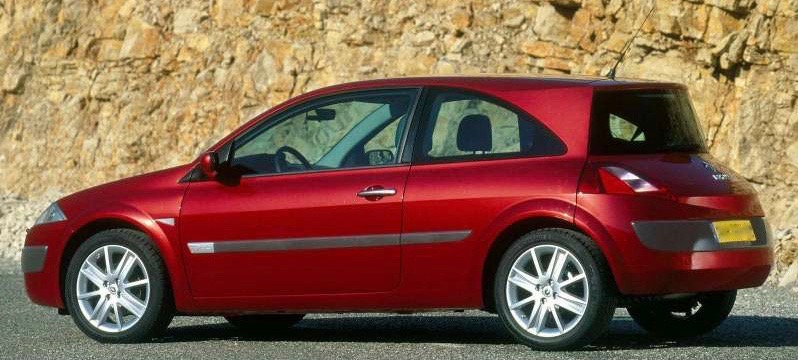The Mégane II's design is one of those I strongly associate with Renault's powerful styling boss Patrick Le Quément (Wikipedia entry here). It is quite similar in spirit to the Vel Satis concept car, and somewhat less so to the production Vel Satis. I dealt with them here.
Le Quément in the early 2000s was trying to have Renaults look French, not as knockoffs of the increasingly internationalized style that was robbing cars of their origin-county identities. He even made a point of hiring non-French stylists who he thought might understand a French look better than native French stylists -- analogous to fish not really understanding their watery environment.
Le Quément's French-look experiment eventually faded, and the 2009 Mégane IIIs had less quirky styling. Nevertheless, the Mégane II (along with the Vel Satises) was an interesting approach to automobile design, as can be seen in the images below.
This view from above shows the Mégane's unusual shape most clearly. The distinctive features are at the rear, and are the similar curves of the rear window, the strike panel (bumper) and character fold towards the bottom of the hatch. These curves are not functional in a mechanical sense, instead functioning in a marketing sense. That is, they are highly distinctive; I can't offhand recall anything quite like this on any other non-Renault production car. (Some cars such as SUVs with station wagon (break) type bodies have rear ends that are curved in plan-view, but in profile they are essentially vertical, unlike the Mégane II.)
The Mégane IIs front combines a curved overall shape with crisp details. The lower air intake is disjointed from the above-the-bumper features.
Rear 3/4 view of a four-door Mégane II. The aft side window, being part of the door ensemble, works much better here than in the two-door version shown in the image below.
The aft side window on two-door Méganes does not tie into the overall theme while seeming to somewhat restrict outward vision for rear-seat passengers. For some inexplicable reason, Honda used a similar design on its 2007 CR-V crossover SUV line.
Another rear view. A problem here is that the curved parts mentioned above do not blend very well with the rest of the car.
It happened that I rented a Mégane II in the fall of 2003, driving various places from Paris to Vienna and back. Yes, it was quirky, but it did a good job.






































